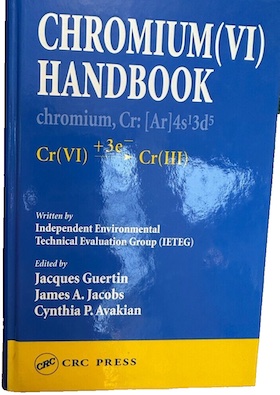
Curated with aloha by
Ted Mooney, P.E. RET

The authoritative public forum
for Metal Finishing 1989-2025

-----
Estimating levels of hexavalent chromium in plated metal parts
Q. We are a manufacturer of mechanical hardware such as latches and handles. We have been receiving inquiries from customers regarding the European Restriction of Hazardous Substances. One of the affected substances is hexavalent chromium, contained in the chromate conversion coatings that are typically used with common platings such as zinc and zinc alloy. My questions follow:
1. What is the typical thickness of a chromate conversion coating?
2. What is the proper method to calculate the level of hexavalent chromium in a plated metal part? The RoHS standard calls out a maximum ppm level as if the part is of homogeneous concentration. Obviously the hexavalent chromium is on the outermost surface of the part.
We are in the process of changing to trivalent chromium. Thank you.
manufacturer of mechanical hardware - Hartford, Connecticut, USA
2005
Q. Have you made any progress measuring the concentration of hex chromate in your parts for RoHS?
I am struggling with this as well. I have contacted 2 independent labs for testing. One lab leaches the hex chromate out of the part and relates it to an assumed chromate coating on the part. The other lab will leach out the hex chromium but has no way to find the amount of the chromate coating on the part. So they give me the amount of CR6 in micrograms/cm^2. This is difficult to relate back to 1000ppm limit RoHS specifies.
Any ideas?
- Englewood, Colorado
2005
Q. I meet the same problem too.
Our fastener supplier ask SGS to do the test for Cr6 ppm, SGS provide a report for Cr6+ ppm divide by in the whole weight of fastener, That not a correct way as we need to find the Cr6+ ppm in homogeneous material.
It's more confusion that SGS told me that they can not separate Cr3+ or Cr6+ in their test.
I hear some Japan company develop their own method to measure Cr6+ ppm . Not sure any one know or not.
- Shenzhen, China
2005
2005
A. A qualitative procedure has now been issued through the German suppliers association ZVO [2],[9] (Zentralverband Oberlächentechik), which enables a qualitative analysis for the content of hexavalent chromium in colorless and colored chromate coatings. The method uses the oxidizing ability of Cr (VI) against Diphenylcarbazide to produce a color change. This change can then be referenced on a color match chart to provide a visual evaluation assessment
Hope this answers your query

V. G. Rajendran
- Trichy, Tamilnadu, India
|
Gentlemen:  Hemant Kumar - Florida, USA 2005 Hemant, the subject in this particular letter is not chrome plating, but the conversion layer caused by application of Cr+3 or Cr+6 solutions after plating by metals other than chrome :-)  Bill Reynolds [deceased] consultant metallurgist - Ballarat, Victoria, Australia We sadly relate the news that Bill passed away on Jan. 29, 2010. 2005 The discussion is about chromate passivation on zinc or zinc alloy, not for chrome plating. Talking chrome plating you are right, chrome is a metal with no valence. Bo KönigFood industry - Odense, Denmark 2005 |
A. There is a procedure for Cr6+ in solid waste (Method# 3060A)from the EPA methods manual SW-846. It involves heating the sample in a buffered alkaline solution that contains components intended to inhibit chromium reduction. The leachate is then tested for Cr6+ by the colorimetric 1,5 diphenylcarbohydrazide [affil links] method. I think this would be suitable for RoHS compliance screening.

Dave Wichern
Consultant - The Bronx, New York
2005
Q. Cr+6 is formed after passivation of Cd plated articles. The labs which test for RoHS compliance sometimes confuse between Cr as metal and Cr+6. And even stainless steels which contain Cr and Ni as major alloying elements are declared as RICH in Cr+6 ... wrongly though. Many believe that Cr+6 either dissolves in water, OR gets diluted in open air or exposure to sunlight. If that is the case, will it not be to advantage to put the parts in boiling water OR expose to sunlight for REDUCTION in the Cr+6 level?
B Pramod- Pune, INDIA
November 5, 2012
Q, A, or Comment on THIS thread -or- Start a NEW Thread
